Ladder:
Ladders are used when employees need to move up or down between two different levels. Slips, trips, and falls are significant contributors to accidents. Slips, trips, and falls can occur when wrong ladder selection is made and when improper climbing techniques and/or defective ladders are used.
Appropriate ladders must be used for the corresponding job and defective ladders will not be used. When hazards exist that cannot be eliminated, then engineering practices, administrative practices, safe work practices, Personal Protective Equipment (PPE), and proper training regarding ladders must be implemented.
Basic Ladder Safety Rules:
- All wood parts must be free from sharp edges and splinters; sound and free from accepted visual inspection from shake, wane, compression failures, decay, or other irregularities.
- Ladders must be maintained in good condition at all times, the joint between the steps and side rails must be tight, all hardware and fittings securely attached, and the movable parts shall operate freely without binding or undue play.
- Metal bearings of locks, wheels, pulleys, etc., shall be frequently lubricated.
- Ladders must be inspected frequently and those which have developed defects must be withdrawn from service for repair or destruction and tagged or marked as "Dangerous, Do Not Use."
- Ladders with broken or missing steps, rungs, or cleats, broken side rails, or other faulty equipment shall not be used; improvised repairs are not allowed.
Step ladder - a self-supporting portable ladder, nonadjustable in length, having flat steps and a hinged back. Its size is designated by the overall length of the ladder measured along the front edge of the side rails.
Single ladder - a non-self-supporting portable ladder, nonadjustable in length, consisting of but one section. Its size is designated by the overall length of the side rail.
Extension ladder - a non-self-supporting portable ladder adjustable in length. It consists of two or more sections traveling in guides or brackets so arranged as to permit length adjustment. Its size is designated by the sum of the lengths of the sections measured along the side rails.
Sectional ladder - a non-self-supporting portable ladder, nonadjustable in length, consisting of two or more sections of ladder so constructed that the sections may be combined to function as a single ladder. Its size is designated by the overall length of the assembled sections.
Trestle ladder - a self-supporting portable ladder, nonadjustable in length, consisting of two sections hinged at the top to form equal angles with the base. The size is designated by the length of the side rails measured along the front edge.
Extension trestle ladder - a self-supporting portable ladder, adjustable in length, consisting of a trestle ladder base and a vertically adjustable single ladder, with suitable means for locking the ladders together. The size is designated by the length of the trestle ladder base.
Special-purpose ladder - a portable ladder which represents either a modification or a combination of design or construction features in one of the general-purpose types of ladders previously defined, in order to adapt the ladder to special or specific uses.
Trolley ladder - a semi-fixed ladder, nonadjustable in length, supported by attachments to an overhead track, the plane of the ladder being at right angles to the plane of motion.
Side-rolling ladder - a semi-fixed ladder, nonadjustable in length, supported by attachments to a guide rail, which is generally fastened to shelving, the plane of the ladder being also its plane of motion. Ladders must not be used in a horizontal position as platforms, runways, or scaffolds. Place portable ladders so that the side rails have a secure footing. The top rest for portable rung and cleat ladders must be reasonably rigid and shall have ample strength to support the applied force.
Safe Ladder Use:
Employees should follow certain rules when placing, ascending, and descending ladders which include:
• Hold on with both hands when going up or down. If material must be handled, raise or lower it with a rope either before going down or after climbing to the desired level.
• Always face the ladder when ascending or descending.
• Never slide down a ladder.
• Be sure shoes are not greasy, muddy, or slippery before climbing.
• Do not climb higher than the third rung from the top on straight or extension ladder, or the second tread from the top on stepladders.
• Carry tools on a tool belt not in the hand.
• Never lean too far to the sides. Keep your belt buckle within the side rails.
• Use a 4 to 1 ratio when leaning a single or extension ladder. (place a 12 foot ladder so that the bottom is 3 feet away from the object the ladder is leaning against.)
• Inspect ladder for defects before using.
• Never use a defective ladder. Tag or mark it so that it will be repaired or destroyed.
• Never splice or lash a short ladder together.
• Never use makeshift ladders, such as cleats fastened across a single rail.
• Be sure that a stepladder is fully open and the metal spreader locked before starting to climb.
• Keep ladders clean and free from dirt and grease.
• Never use ladders during a strong wind except in an emergency and then only when they are securely fastened.
• Never leave placed ladders unattended.
• Never use ladders as guys, braces, or skids, or for any other purpose other than their intended purposes.
• Never attempt to adjust a ladder while a user is standing on the ladder.
• Never jump from a ladder. Always dismount from the bottom rung.
Ladder extension:
- Place ladders on a firm, level surface and ensure the footing is secure.
- Erect extension ladders so that the upper section rests on (e.g., in front of) the bottom section. This means the bottom section "faces" a wall or other supporting surface (see figures below).
- Place the ladder feet so that the horizontal distance between the feet and the top support is 1/4 of the working length of the ladder. The ladder will be leaning at a 75 degree angle from the ground.
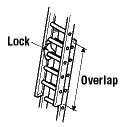
- Raise and lower ladders from the ground. Ensure that locking ladder hooks are secure before climbing.
- Erect ladders so that a minimum of 1 m (3 ft) extends above a landing platform. Tie the top at support points.
- Brace or tie off the ladder near the base. If there is no structure to tie off to, use a stake in the ground.
- Leave all tie-off devices in place until they must be removed before taking the ladder down.
- Maintain the minimum overlap of sections as shown on a ladder label. Refer to safety regulations.
Note: When working 3 metres (10 feet) or more above ground, wear a safety belt or harness with the lanyard tied appropriately to the structure.
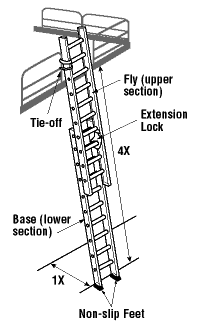
Avoid when using extension ladders:
- Do not use ladders near electrical wire.
- Do not set up or take a ladder down when it is extended.
- Do not overextend. Maintain minimum overlap of sections.
- Do not climb higher than the fourth rung from the top of a ladder.
- Do not use ladders on ice, snow or other slippery surfaces without securing ladders' feet.
- Do not extend top section of a ladder from above or by "bouncing" on a ladder.
- Do not leave ladders unattended.
Climbing a fixed ladder:
- Wait until the other person has exited before ascending or descending.
- Use the appropriate safety devices (e.g., restraint belt, traveling fixture).
- Maintain three-point contact by keeping two hands and one foot, or two feet and one hand on a ladder always.
- Face ladder and use both hands to grip the rungs firmly.
- Place feet firmly on each rung.
- Wear footwear with heels. Ensure that footwear is in good condition.
- Clean muddy or slippery boot soles before mounting a ladder.
- Rise or lower tools and materials using a hand-line.
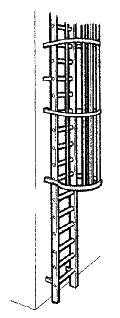
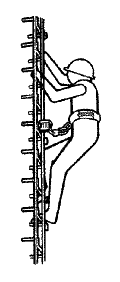
How should you set up the ladder:
- Place the ladder feet 1/4 of the ladder's working length (e.g., foot to top support point) away from the base of the structure (e.g., for every 1.2 m (4 ft ) high, the base of the ladder should be out 0.3 m (1 ft); that means one horizontal foot from the support point).
- Extend the ladder at least 1 m (3 ft) above the landing platform.
- Place the ladder on a firm, level footing. Use a ladder with slip-resistant feet or secure blocking. Brace or tie the bottom of the ladder.
- Rest both side rails on the top support and secure ladder to prevent slipping.
What should you know about climbing portable ladders:
- Check for overhead electrical wires before setting up a ladder.
- Clear area around base and top of the ladder of debris, tools and other objects.
- Tie off yourself with a safety harness when working 3 m (10 ft) or more off the ground or when working with both hands.
- Ensure that only one person is on a single-width ladder. Only one person is allowed on each side of a double-width ladder.
- Maintain three-point contact by keeping two hands and one foot, or two feet and one hand on the ladder at all times.
- Grasp the rungs when climbing a ladder, not the side rails. If your foot slips on a ladder, holding onto rungs is easier than holding onto the side rails.
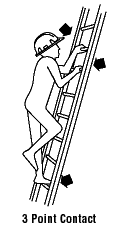
- Wear protective footwear with slip-resistant soles and heels.
- Ensure that all electrical equipment used during ladder work is in good condition and properly grounded.
- Rest frequently to avoid arm fatigue and disorientation when the work requires you to look up and reach above your head.
- Drape your arms over a rung and rest your head against another rung or side rail if you become dizzy or panicky. Climb down slowly.
Proper way to store ladders:
- Return ladders to storage area after use.
- Store ladders where they are protected from the weather.
- Support ladders horizontally on racks. To prevent sagging, support ladders every 2 m (6 ft).
- Keep ladders clean and free of foreign materials.
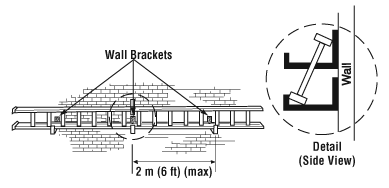
- Ensure that storage areas are easy to reach.
- Keep wooden ladders in a well-ventilated location, away from dampness and excessive heat.
- Avoid long overhangs beyond support points when transporting ladders on vehicles.
- Pad racks on vehicles with soft material to reduce wear and road shocks.

- Tie ladders to each support point to reduce damage.
- Mark ladders which overhang vehicles with a red or orange flag.
- Grasp ladders near the center when carrying them.
- Use caution when carrying ladders through passageways, doorways or any place where your view is obstructed.
- Use a partner to help carry long or heavy ladders.
- Ensure that you and your partner are on the same side when carrying a ladder. Stay in step. Work out in advance any hand or voice signals to coordinate stopping or changing direction.

Avoid when storing ladders:
- Do not hang ladders from rails or rungs.
- Do not store materials on ladders.
- Do not expose fiberglass ladders to excessive temperatures (above 93°C or 200°F).
- Do not hold the front of ladders at head level when carrying them.
- Do not expose plastic-reinforced ladders to excessive sunlight. Ultraviolet light may cause the plastic resins to degrade. If the strength of the ladder is questionable, replace the ladder.
When using a stepladder:
- Use a stepladder that is about 1 m (3 ft) shorter than the highest point you have to reach. This gives a wider, more stable base and places shelf at a convenient working height.
- Open the stepladder spreaders and shelf fully.
- Check stability. Ensure that all ladder feet are on a firm, level and non-slippery surface.
- Place a stepladder at right angles to the work, with either the front or back of the steps facing the work.
- Keep the stepladder close to the work.
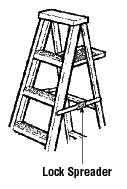
- Avoid pushing or pulling stepladders from the side. Repeated sideways movement can make ladders wobbly since they are weaker or less stable in those directions.
- Face the stepladder when climbing up or down. Keep your body centered between side rails. You have climbed too high if your knees are above top of the stepladder or if you cannot maintain a handhold on the ladder.
- Maintain a firm grip. Use both hands when climbing.
When using a stepladder:
- Do not overreach. Move a stepladder when needed.
- Do not "shift" or "walk" a stepladder when standing on it.
- Do not stand, climb, or sit on the stepladder top or pail shelf.
- Do not overload. Stepladders are meant for one person.
- Do not use a stepladder as a brace or as a support for a work platform or plank.
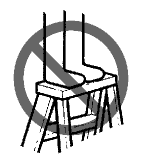
- Do not climb a stepladder that is leaning against a wall. Use a straight ladder instead.
- Do not use stepladders on slippery surfaces.
- Do not use stepladders on soft ground where one leg may sink farther into the ground than others.
- Do not place stepladders on boxes, unstable bases or on scaffolds to gain additional height.
- Do not climb the back of a stepladder.
- Do not push or pull stepladders sideways.
- Do not use ladders in passageways, doorways, driveways or other locations where a person or vehicle can hit it. Set up suitable barriers or lock doors shut.

Click the below link to know more detail about Ladder safety

Portable Ladder- Safety Check sheet
Fixed ladder - Safety check sheet
Ladder safe extension - OSHA Fact sheet
